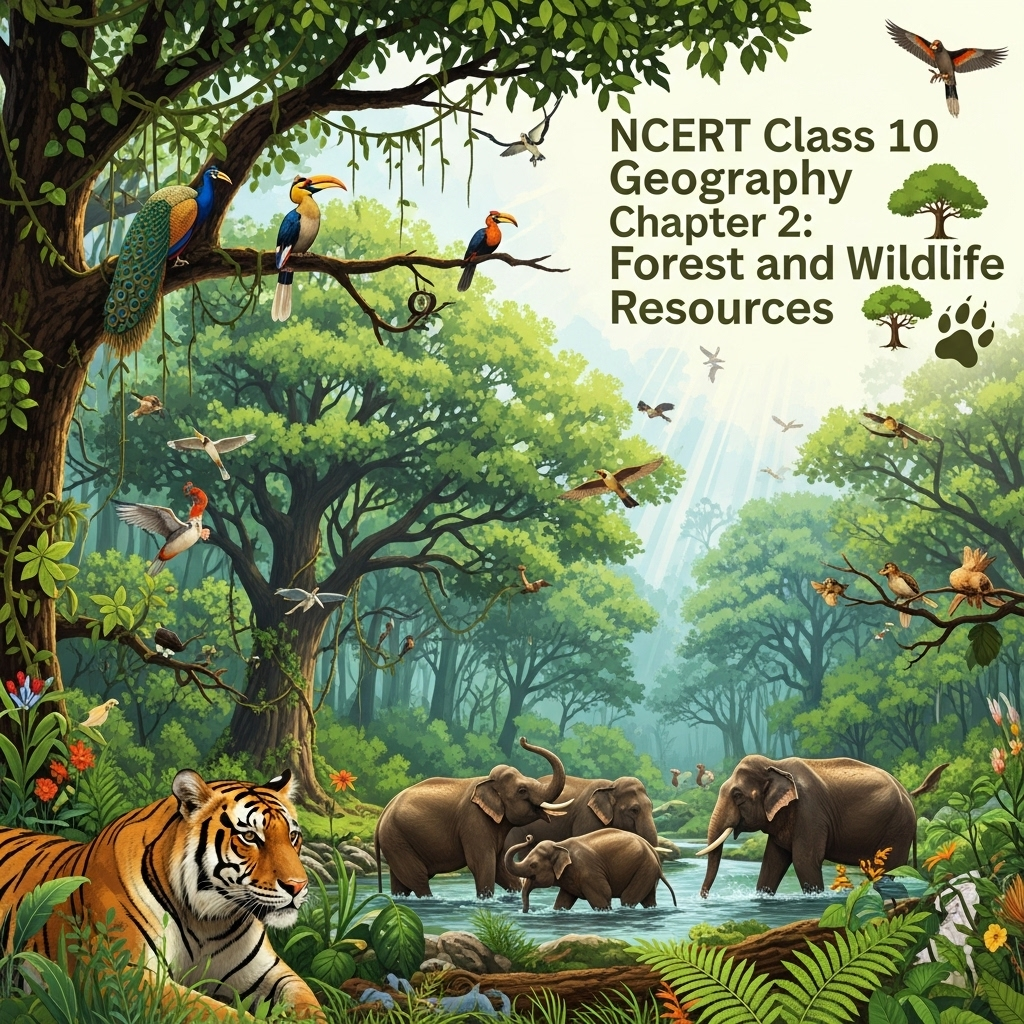Complete Solutions and Summary of Forest and Wildlife Resources – NCERT Class 10, Geography, Chapter 2 – Summary, Questions, Answers, Extra Questions
Detailed summary and explanation of Chapter 2 ‘Forest and Wildlife Resources’ covering biodiversity, types and distribution of forests, wildlife species, conservation challenges, community involvement, joint forest management, and traditional practices, with all question answers, map skills, and extra questions from NCERT Class X Geography.
Updated: 2 months ago
Categories: NCERT, Class X, Geography, Summary, Extra Questions, Forests, Wildlife, Biodiversity, Conservation, Community Management, Chapter 2

Forest and Wildlife Resources
Chapter 2: Geography - Complete Study Guide | NCERT Class 10 Notes & Questions 2025
Comprehensive Chapter Summary - Forest and Wildlife Resources Class 10 NCERT
Overview
- Chapter Purpose: Explains biodiversity as a complex web of ecosystems where humans depend on flora, fauna, air, water, soil. Lepcha folk song highlights harmony with nature. Biodiversity: Immensely rich in wildlife and cultivated species, diverse in form/function, integrated through interdependencies. Figure 2.1: Tribal activities in forests. Immense biodiversity in India, twice/thrice undiscovered. Flora/fauna integrated in daily life but under stress due to insensitivity. Activity: Find stories on human-nature harmony.
- Expanded Relevance 2025: With climate change, focus on deforestation, species extinction; sustainable conservation via JFM. Update: Biodiversity hotspots, IUCN lists.
- Exam Tip: Distinguish forest types; use maps for sanctuaries/parks; know projects like Tiger.
- Broader Implications: Forests support life systems; depletion affects ecology, genetics, breeding.
Flora and Fauna in India
- Characteristics: India rich in biodiversity; unique regional species. Vast array, possibly twice/thrice undiscovered. Studied forest/wildlife variety, importance in daily life. Diverse flora/fauna integrated but stressed. Figure 2.2: Rhino/deer in Kaziranga.
Conservation of Forest and Wildlife in India
- Background: Rapid decline needs conservation for ecological diversity, life support (water/air/soil), genetic diversity for breeding (agriculture/fisheries depend on traditional varieties/aquatic biodiversity).
- Indian Wildlife (Protection) Act 1972: Provisions for habitats, all-India protected species list, ban hunting, legal protection, restrict trade. Central/state governments established parks/sanctuaries.
- Projects: For endangered: Tiger, one-horned rhino, Kashmir stag (hangul), crocodiles (fresh/saltwater/gharial), Asiatic lion, Indian elephant, black buck (chinkara), great Indian bustard (godawan), snow leopard. 1980/1986 notifications added insects (butterflies/moths/beetles/dragonfly); 1991 plants (six species).
- Project Tiger: Launched 1973; tiger population dwindled to 1,827 from 55,000. Threats: Poaching, shrinking habitat, prey depletion, human growth. Trade skins/bones (Asian medicines). India/Nepal habitat two-thirds world tigers, targets for illegal trade. Preserves biotypes. Reserves: Corbett (Uttarakhand), Sunderbans (WB), Bandhavgarh (MP), Sariska (Rajasthan), Manas (Assam), Periyar (Kerala).
- Shift to Biodiversity: Focus on all components, intensive search for measures, insects/plants added.
Types and Distribution of Forest and Wildlife Resources
- Challenges: Difficult to manage/control; mostly government-owned/managed by Forest Department.
- Reserved Forests: >50% total forest land; most valuable for conservation.
- Protected Forests: ~1/3 total; protected from depletion.
- Unclassed Forests: Others/wastelands (government/private/communities).
- Permanent Forests: Reserved/protected for timber/produce/protection. MP 75% reserved; J&K/AP/Uttarakhand/Kerala/TN/WB/Maharashtra high reserved; Bihar/Haryana/Punjab/HP/Odisha/Rajasthan high protected; NE states/Gujarat high unclassed (community-managed).
- Activity: Collect info on sanctuaries/parks, cite on India map.
Community and Conservation
- Traditional Role: Forests home to communities; struggle with officials for livelihoods. Sariska (Rajasthan): Villagers fought mining citing Wildlife Act. Alwar (Rajasthan): 1,200 ha Bhairodev Dakav ‘Sonchuri’ (rules ban hunting/protect wildlife).
- Chipko Movement: Himalayas; resisted deforestation, successful community afforestation with indigenous species.
- Beej Bachao Andolan/Navdanya: Tehri; diversified crop production without synthetics, viable.
- Joint Forest Management (JFM): 1988 Odisha first resolution; village institutions protect degraded forests; benefits: Non-timber produce, timber share. Local involvement key; accept people-centric, environment-friendly, rewarding activities.
- Gharial on Brink: Population decline since 1970s; threats, conservation issues. Activity: Reasons for problems (e.g., habitat loss, poaching).
Sacred Groves - A Wealth of Diverse and Rare Species
- Nature Worship: Age-old tribal belief; protect creations. Sacred Groves: Virgin forests untouched, interference banned.
- Examples: Mundas/Santhal worship mahua/kadamba; Odisha/Bihar tamarind/mango weddings. Peepal/banyan sacred. Cultures conserve: Springs/peaks/plants/animals protected. Macaques/langurs temples; Bishnoi (Rajasthan) protect blackbuck/nilgai/peacocks.
- Quote: Tree's kindness (Gautama Buddha).
- Activity: Essay on everyday conservation practices.
SEO Note: Why This Guide?
Top-ranked for 'Forest and Wildlife Resources Class 10 notes 2025'—free, with 60 Q&A from PDF, quizzes. Integrates conservation insights.
Key Themes
- Biodiversity Importance: Ecological/genetic support.
- Conservation Efforts: Acts/projects/community roles.
- Forest Types: Distribution/percentages.
- Critical Thinking: Why depletion? Community success.
Cases for Exams
Chipko, Project Tiger; discuss sacred groves, JFM objectives.
Exercises Summary
- Focus: Expanded to 60 Q&A from PDF: 20 short (2M), 20 medium (4M), 20 long (8M) based on NCERT exercises + similar.
- Project Idea: Map marking parks; essay on practices.
Group Discussions
No forum posts available.


